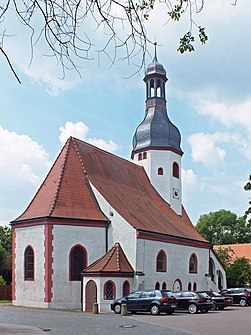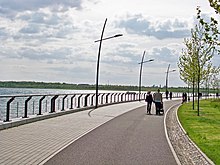Markkleeberg-East
|
Markkleeberg-East
Large district town of Markkleeberg
Coordinates: 51 ° 16 ′ 38 " N , 12 ° 23 ′ 37" E
|
|
|---|---|
| Height : | 115 m above sea level NHN |
| Incorporation : | 1934 |
| Postal code : | 04416 |
| Area code : | 0341 |
|
Auenkirche
|
|
Markkleeberg-Ost is one of the eight districts of the large district town of Markkleeberg in the district of Leipzig in Saxony and was named as Markkleeberg when the city was founded in 1934. It is sometimes also referred to as Alt-Markkleeberg.
Location and local characteristics
Markkleeberg-Ost borders in the west along the course of the river Pleiße on the former Oetzsch (Markkleeberg-Mitte), in the north on Dölitz and Dosen (both belonging to Leipzig ). In the east, Markkleeberg-Ost borders the Markkleeberg district of Wachau with the Auenhain settlement . The Markkleeberger See forms the southern boundary of the settlement .
Markkleeberg-Ost is an almost entirely residential area. In addition to the village-like historical area around Kirchstrasse and Krobitzschstrasse, there are three larger settlement areas: the musicians' quarter adjacent to Dölitz, built around 1910 by wealthy Leipzig citizens with street names after composers, the area of the “Goldene Höhe” settlement association from that time, which extends towards Wachau after 1930 and the new Rathenaupark buildings around Rathenaustraße after 1990.
The undeveloped area is meadow terrain in the west with a floodplain character , through which the Kleine Pleiße flows, the old course of the Pleiße and now the outflow from the Markkleeberger See. In the east, arable land dominates, with the exception of the Weinteichsenke , one of the last Pleißenbach meadows in the south of Leipzig.
The ensemble of the former manor, Auenkirche and former village school is located about 300 meters west of the old town center on the Kleine Pleiße.
history
From 1895 on , numerous stone tools were found at the so-called Markkleeberg site , which is today near the northern edge of the Markkleeberger See , which testify to human settlement in the area from the Middle Paleolithic .
Well
The written history of Markkleeberg (today's Markkleeberg-Ost) begins with its first mention in 1190, when Bere de Cleberg appeared as a notary for a sale of the village of Altranstädt to the Altzelle monastery . In 1210 she speaks of a manor of Conradus de Cleberg, from which a manor emerged . Heinrich von Haldeken was feudal lord and court lord from around 1348 . The von Haugwitz family owned the property for several generations . Via Moritz von Starschedel and Joachim Anckelmann , who rebuilt the Auenkirche after a fire, the estate came to Statz Friedrich von Fullen when he married the widowed Anna Katharina Metzner, a daughter of Joachim Anckelmann. Von Fullen had the manor house rebuilt in the early Baroque style. His son Statz Hilmar von Fullen sold the estate to Johann Christoph von Lohse, whose daughter married it into the Funcke family. After a few more changes of ownership, the last man at Gut Markkleeberg was Paul Hoppe, who introduced modern agricultural methods.
The ensemble around Markkleeberg Castle with the gatehouse and the Auenkirche was involved in fighting on October 16, 1813 in the course of the Battle of Nations around the castle and the Pleiße crossing.
After the expropriation in 1945, the Markkleeberg Castle became an experimental estate and the mansion became a children's hospital, later a nursing home for the elderly. After 1990 the heirs bought back the manor house and gatehouse of the manor and established a local museum with a lively support association in the gatehouse, in which there is also an exhibition on the Battle of Leipzig in 1813.
Village
The layout of the street village is traced back to seven Flemish farmers at the time of the Bere de Cleberg. For 1552 21 possessed men , 4 cottagers and 22 residents are given. The village developed between the old course of the Pleiße and the trunk road coming from Leipzig, the Via Imperii . Whitsun 1539 the first evangelical sermon was held in St. Mary's Church, and the first school was established in 1566.
The village experienced numerous hardships over the centuries: fires in 1571, 1574, 1612, 1639, 1679, 1720, the plague in 1633 and finally the fighting for the manor and the Pleiße crossing during the Battle of Nations on October 16, 1813.
While urbanization progressed in Oetzsch and Gautzsch around the turn of the 20th century (industry and multi-storey apartment buildings), this was not the case in Markkleeberg. Nevertheless, by the turn of the century, the population of Markkleeberg grew to almost a thousand. In 1908 the community built a town hall on Bornaische Strasse. In 1911 it was connected to the electrical power and water networks.
To counteract the threat of incorporation into Leipzig, Oetzsch and Markkleeberg merged to form the municipality of Oetzsch-Markkleeberg in 1915. Their town hall was the one in Markkleeberg until 1921, when the Gasthof Zur Linde in Oetzsch was converted into the new town hall. In 1928 Markkleeberg was connected to the Leipzig tram network by extending the line from Dölitz.
district
In 1934, Oetzsch-Markkleeberg and Gautzsch were combined to form the town of Markkleeberg. It was the first city to be founded under National Socialist rule. Markkleeberg became Markkleeberg-Ost.
In March 1939 the writer Antoine de Saint-Exupéry visited the nursery of the parents of the publisher Karl Rauch in Markkleeberg-Ost. In the house in front of the nursery Bornaischen Str. 35 (preserved), Karl Rauch ran his publishing house until 1945: On September 6, 1939, the German translation of de Saint-Exupéry's novel “ Wind, Sand and Stars ” was published for the first time.
Because of the lack of industry, Markkleeberg-Ost suffered hardly any war damage during World War II .
Until 1980, the Espenhain opencast mine worked its way up to the settlement boundary of Markkleeberg-Ost, before turning to the east. It was only from 1999 to 2006 that the lunar landscape he left behind changed into the Markkleeberger See.
Infrastructure
traffic
The Leipziger Verkehrsbetriebe are responsible for local public transport. Its longest tram line 11 connects the two endpoints Markkleeberg-Ost and Schkeuditz via Leipzig city center. The single-track track stretch from the city limits is reached via the Virchowstraße stop to the Schillerplatz final stop, where there is a turning loop. The 106 bus runs every 30 minutes on weekdays between the Markkleeberg districts.
Markkleeberg has been accessible from the A 38 via the Leipzig-Süd junction since 2006 .
In addition to the road network, a large number of cycle paths can be used, with the area around the Markkleeberger See being particularly developed.
education and parenting
- The Markkleeberg-Ost primary school is a building built in 1904 and renovated in 1995 in Rilkestrasse with an after- school care center from 2010.
- The day care center “Arche Noah” for up to sixty children is located next door on Goethestrasse. It was built in 1999 by the town of Markkleeberg and has been operated since then under the sponsorship of the Auenkirch community.
Attractions
- Castle with gatehouse (Regional Museum Völkerschlacht 1813) and rhododendron park
- Auenkirche
- Markkleeberger See with lake promenade, lido, ship landing stage and restaurants
- Several apple stones
Personalities
- Valentin Otto (1529–1594), musician and Leipzig Thomaskantor, born in Alt-Markkleeberg
- Karl Rauch (1897–1966), publisher, writer and translator, born in Alt-Markkleeberg
- Willy Nebel (1897–1985), professor of mechanical technology and former rector of the Karl-Marx-Stadt University of Mechanical Engineering, born in Alt-Markkleeberg
- Momme Mommsen (1907–2001), German-American literary scholar, born in Alt-Markkleeberg
- Antoine de Saint-Exupéry (1900–1944), visited the Karl-Rauch-Verlag in 1939 and the nursery of the publisher's parents on Bornaische Strasse.
literature
- Diana Hartrich, Peter Schug, Andreas Höhn, Thomas Nabert , Michael Zock, Otto Werner Förster : Markkleeberg - History and Change . ProLeipzig 2009, ISBN 978-3-936508-48-2
- ProLeipzig (Ed.): In the Pleiße and Göselland. Between Markkleeberg, Rötha and Kitzscher . Leipzig 1999, ISBN 3-9806474-1-2 , pp. 49-65
Web links
- Official website of the city of Markkleeberg
- Markkleeberg in the Digital Historical Directory of Saxony
- Torhaus Markkleeberg - historical ensemble around the manor Markkleeberg and a history society
Individual evidence
- ↑ Markkleeberg - History and Change , p. 34
- ↑ Description of the fighting around the Markkleeberg Pleiße crossing on October 16, 1813 on the Torhaus Markkleeberg website
- ↑ Markkleeberg - History and Change , p. 132
- ↑ Historical index of places
- ↑ Markkleeberg - History and Change , p. 73
- ↑ Sabine Knopf: "Where Hitler is king, there is no place for me" Antoine de Saint-Exupéry's visit to Germany in 1939. In: Kulturstiftung Leipzig. (Ed.): Leipziger Blätter. tape 60 . Passage-Verlag, 2012, ISSN 0232-7244 , p. 67-69 .
- ^ Leipziger Verkehrsbetriebe: Timetable of the Leipziger Gruppe. Retrieved January 5, 2020 .
- ↑ Markkleeberg-Ost primary school. In: Website of the city of Markkleeberg. Retrieved March 27, 2019 .
- ^ "Noah's Ark" daycare center. In: Website of the city of Markkleeberg. Retrieved March 27, 2019 .






